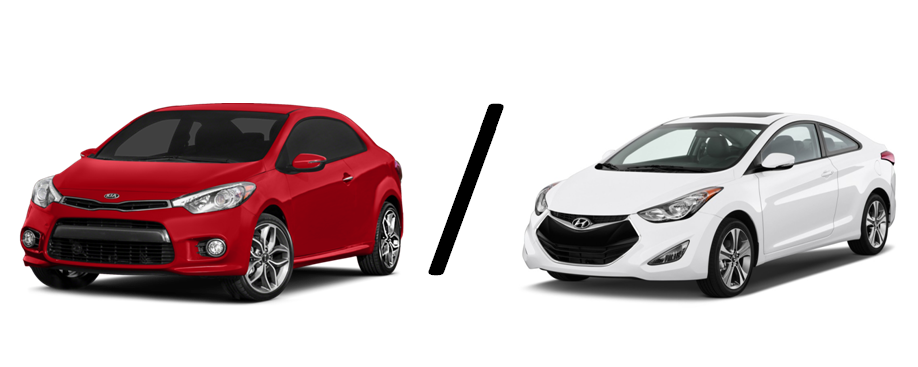
Hyundai and Kia have an interesting relationship. They're separate
automakers, with distinct design language and a driving feel all their own. Yet
they share the same South Korean parent company, as well as car platforms, powertrains, and
other core technologies.
The Hyundai Elantra and Kia Forte sedans are a good example of
the excellent job the companies have done in differentiating their similar
offerings. The compact sedans have common roots, but to us, the Elantra's
EPA-rated fuel economy advantage outweighs some minor and very subjective
differences in styling and interior comfort.
No doubt, it's the Hyundai Elantra that first turned heads.
Introduced as a 2011 model, it stands out from a distance. The "fluidic
sculpture" theme is sporty, modern, and dynamic, and we like the mix of
its wedgy stance and curvy details. The Forte's redesign for the 2014 model
year has seen it grow a little to almost exactly the same proportions, but to
an altogether more European-influenced effect. Its crisp details and gently
arched roofline are inspired reinterpretations of classic compact-car profiles,
with Kia's corporate face carving out its own identity.
Inside, it's the same story for both cars, with the Elantra
making waves with its fashion-forward details and distinctive hourglass center
console, while the Forte takes a more simplified design direction that's
refreshing and easy to navigate. Overall, we rate the Elantra more highly for
its brand-resetting look--but we realize it's a matter of taste and opinion.
(The Elantra also comes in a new two-door body style as well as a
five-door Elantra GT hatchback version, while the Forte also comes as a
two-door Koup and as a five-door hatch, which we haven't yet driven as 2014
models. Here, we're content to stay, er, focused on the most popular four-door
versions.)
On the performance front, the Forte finally has gained the more advanced
four-cylinder powertrain the Elantra's had since 2011, but it also offers a
larger-displacement 2.0-liter four with 173 horsepower (which, by the way, the
Elantra has also inherited for 2014). The bump over the 148-hp, 1.8-liter four
in the Elantra (and in the base Forte, which hasn't been made available for
testing) isn't of a magnitude that will have enthusiasts dropping GTI brochures
in the dust. On the other hand, the 2014 Hyundai Elantra gains three-mode
steering on the SE and Limited sedan, stiffer shocks and springs and a bigger
stabilizer bar on the Sport sedan, and revised steering feel for all the models
in its lineup.
It's a touch more smooth and silent in daily use than the old Forte
fours, but it comes with a fuel economy penalty: top Elantras earn up to 32 mpg
EPA combined, but the Forte's best effort--with optional stop/start--is 29 mpg
combined. In the wider view, we think those numbers are more important to
buyers of these cars.
Where the Forte does a little more with standard-issue hardware is
in its dynamic feel. Its electric power steering is a step ahead of the
Elantra's setup, and overall the Forte's independent front and torsion-beam
rear suspension is more firmly tuned, with a more spry driving feel. That
somewhat firmer suspension setup doesn't much affect the Forte's ride. It's no
more busy than that of the Hyundai, and the Forte seems quieter, too, though
these are both relatively quiet cars within their class.
As for interior room, the cars now ride on identical wheelbases and
have almost exactly the same interior dimensions, though the Elantra's leg room
is biased toward the front seat, the Forte's more evenly split. Neither has
great rear-seat head room.
The Kia Forte and Hyundai Elantra are in theory
built on the same platform, so it's puzzling that their safety ratings are so
different. While the Elantra is one of the segments top performers, with IIHS
Top Safety Pick status and even a respectable 'acceptable' score in the tough
small overlap frontal test, the Forte gets a 'poor' rating in that test, as
well as a lower four-star Overall Rating in federal crash tests (including a
lower three-star frontal crash score. Otherwise, safety equipment is comparable
between the two models, with the requisite airbags and stability control
complemented by standard Bluetooth and an available rearview camera.
The Forte has caught up with the Elantra's
features list. Both have standard power features, cruise control, air
conditioning, and satellite-radio hardware. Hyundai's options list includes
heated rear seats, a proximity key system, push-button start, and a navigation
system and infotainment system with one of the largest screens among compact cars.
It also supports Bluetooth audio streaming, and the nav system includes voice
controls and XM Data services. Forte shoppers can now get all those features,
with a twist: the UVO infotainment controller is a new, superior,
smartphone-driven system that uses cell data to get mapping information and to
stream audio.
Now
that the gap in generations has closed between the Forte and the Elantra,
there's less distinction than ever between their spec sheets; although the
Hyundai seems to have an edge in many respects.

